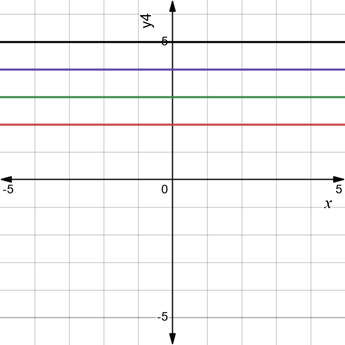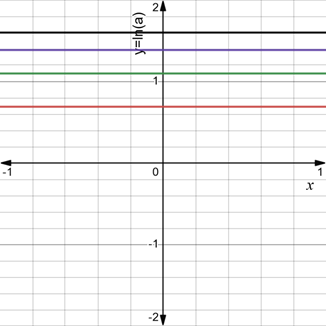
(a)
To find: The graph of
(a)
Answer to Problem 69E
Graph is given.
Explanation of Solution
Given information:
Calculation:
The meaning of
Differentiate
To find the value of
Now given that
Draw the graph of
The graph will be the horizontal lines as
When
When
Similarly, for other values of
The graph for different values of

For equation

It can be seen that as the exponent increases, the curves get steeper and the rate of growth increases respectively. A function which grows faster than a polynomial function is
Thus, the exponential function having base greater than 1, i.e.,
It must be noted that the exponential function is increasing and the point
(b)
To find: The graph of
(b)
Answer to Problem 69E
The graph is given and values of
Explanation of Solution
Given information:
Calculation:
The meaning of
Differentiate
To find the value of
Draw the graph of
When
When
When
The graph of

For
Therefore the values of
Basically the value found of
Here,
Table of values of
| 2 | 3 | 4 | 5 | |
| 0.69 | 1.098 | 1.386 | 1.60 |
(c)
To find: How part
(c)
Explanation of Solution
Given information:
Calculation:
The meaning of
Differentiate
To find the value of
In part (a) the value
If
Recall the fact that exponent and log functions are inverse to each other therefore
Hence
This proves that if
Hence proved.
(d)
To find: prove algebraically
(d)
Explanation of Solution
Given information:
Calculation:
The meaning of
Differentiate
If
Therefore it can be written as
Chapter 3 Solutions
Advanced Placement Calculus Graphical Numerical Algebraic Sixth Edition High School Binding Copyright 2020
 Calculus: Early TranscendentalsCalculusISBN:9781285741550Author:James StewartPublisher:Cengage Learning
Calculus: Early TranscendentalsCalculusISBN:9781285741550Author:James StewartPublisher:Cengage Learning Thomas' Calculus (14th Edition)CalculusISBN:9780134438986Author:Joel R. Hass, Christopher E. Heil, Maurice D. WeirPublisher:PEARSON
Thomas' Calculus (14th Edition)CalculusISBN:9780134438986Author:Joel R. Hass, Christopher E. Heil, Maurice D. WeirPublisher:PEARSON Calculus: Early Transcendentals (3rd Edition)CalculusISBN:9780134763644Author:William L. Briggs, Lyle Cochran, Bernard Gillett, Eric SchulzPublisher:PEARSON
Calculus: Early Transcendentals (3rd Edition)CalculusISBN:9780134763644Author:William L. Briggs, Lyle Cochran, Bernard Gillett, Eric SchulzPublisher:PEARSON Calculus: Early TranscendentalsCalculusISBN:9781319050740Author:Jon Rogawski, Colin Adams, Robert FranzosaPublisher:W. H. Freeman
Calculus: Early TranscendentalsCalculusISBN:9781319050740Author:Jon Rogawski, Colin Adams, Robert FranzosaPublisher:W. H. Freeman
 Calculus: Early Transcendental FunctionsCalculusISBN:9781337552516Author:Ron Larson, Bruce H. EdwardsPublisher:Cengage Learning
Calculus: Early Transcendental FunctionsCalculusISBN:9781337552516Author:Ron Larson, Bruce H. EdwardsPublisher:Cengage Learning





